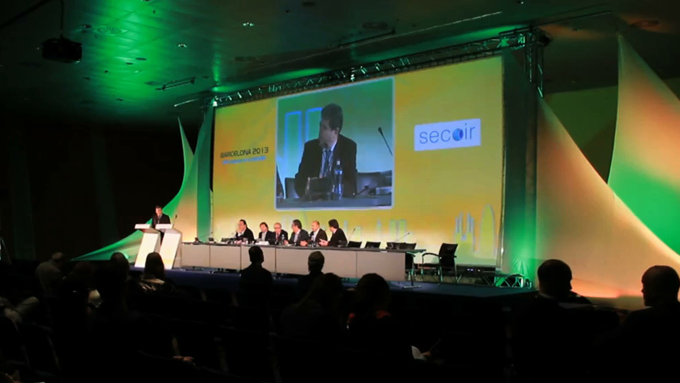IMO’s Cornea and Refractive Surgery Department was responsible for organising the Spanish Society of Refractive and Ocular Implant Surgery’s (SECOIR) 28th Annual Conference for Spanish anterior segment specialists mainly dedicated to refractive surgery and intraocular lens implantation.
The conference, which took place from 15 to 18 May in Barcelona, was chaired by Dr Daniel Elies, who, along with his colleagues from IMO, Dr José Luis Güell and Dr Óscar Gris, managed to bring together more than 850 ophthalmologists, 150 optometrists and 150 ophthalmic nurses to address the latest developments in the field. During the event, more than 100 videos were shown and over 800 presentations, talks and lectures were given within a scientific programme, selected by the ophthalmologists from IMO, that went down very well with the attendees.
The femtosecond laser, a technology that “is here to stay”
The main conclusion of the conference this year was the consolidation of the femtosecond laser as a leading technique in refractive and cataract surgery. Although it only appeared just over a year ago, the specialists confirmed that it had already become a treatment of choice among ophthalmologists and predicted that it would have a long future, as it is a technique that continues to evolve rapidly.
According to Dr Daniel Elies, “it is a technology that is here to stay, because it represents a highly significant qualitative leap forward that is yet to fulfil its full potential.” Specialists agree that the laser’s major contribution is reproducibility in that it is able to repeat the same procedure 100 times in exactly the same way. This technique also offers great safety and predictability and makes it possible to perform multiple procedures, such as incisions, cuts, fractures in different corneal structures and fragmentation of the hard nucleus of the cataract.
According to Dr Elies, “it is a way of standardising surgery. There were aspects that, until recently, had to be done manually, such as incisions with a scalpel. Even the best surgeon in the world cannot make 100 circles exactly the same, but the femtosecond can.” Despite these advantages, IMO specialist reminds us that it is a tool and that “we shouldn’t detract from the work of the programmer: technology has to be designed, programmed and correctly indicated.” Because of this, the chairman of the organising committee of SECOIR 2013 concludes that “this robotisation of surgery ensures that, if surgeons programme, indicate and perform procedures well, we can get increasingly closer to the best possible outcome.”
Correcting presbyopia with multifocal intraocular lenses and monovision
The conference also addressed the correction of presbyopia through the use of two main strategies: the implantation of multifocal intraocular lenses and monovision, which involves one eye being used for distance vision and the other for near vision.
Intracorneal implants
Particularly noteworthy in another group of indications are intracorneal implants, which are small devices that are 5.10 microns thick by 1 or 1.5 mm in diameter, which are implanted in the visual axis of the cornea to change the curvature or dioptric power and, therefore, improve near vision. According to the specialists, the implants do not totally compensate the presbyopia that a person of 65 can have and with three dioptres, but they can compensate the shortfall in a person between the ages of 45 and 50, who has not fully developed presbyopia and could have one dioptre or a dioptre and a half.
Keratoconus treatments and lamellar corneal implants
Another of the main themes of the SECOIR conference was the use of intracorneal rings and cross-linking for the treatment and improvement of various types of keratoconus, as well as the growing importance of partial corneal transplantation or lamellar surgery.
The Spanish Society of Refractive and Ocular Implant Surgery (SECOIR)
The Spanish Society of Refractive and Ocular Implant Surgery was founded over 30 years ago and is currently the second most important ophthalmology society in Spain. SECOIR holds an annual conference that takes place in different Spanish cities. The location of each conference and composition of the organising committee are decided by a vote of the members of the society, who, in the last ballot, entrusted the organisation of the 28th edition to the doctors of IMO. For the organisation of this important event, it is essential to select leading national or international ophthalmologists who can contribute innovative ideas or highly-relevant scientific knowledge, as well as the ability to decide on the content of lectures and group them by thematic areas of interest.
